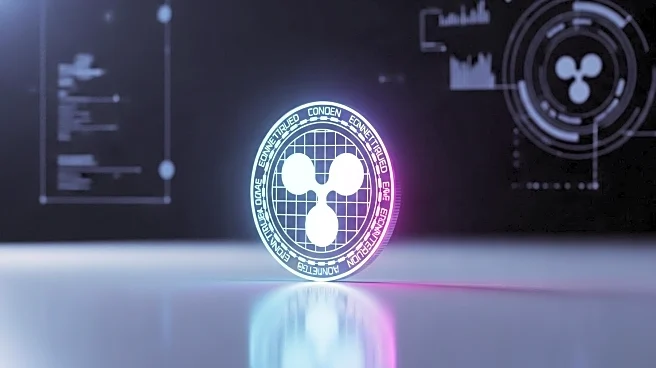What's Happening?
Artificial intelligence tools are being utilized to forecast potential price trajectories for XRP, Ripple's native digital asset, by the end of 2025. These models consider factors such as regulatory developments, market sentiment, and technological advancements. As of October 2025, XRP is trading at approximately $2.80, with a market capitalization of $166.9 billion. The U.S. Securities and Exchange Commission (SEC) is reviewing several XRP ETF applications, part of over 90 exchange-traded products awaiting approval. Analysts have noted significant investor demand for XRP ETFs, with projections of substantial inflows similar to those seen with Bitcoin and Ethereum ETFs. Ripple has also applied for a U.S. national bank charter, aiming to offer custody and specialized banking services under federal oversight, potentially enhancing its credibility and reducing operational costs for cross-border transactions.
Why It's Important?
The approval of XRP ETFs could significantly impact the cryptocurrency market, potentially leading to substantial inflows and increased investor interest. Ripple's strategic moves, including its application for a national bank charter, could enhance its operational capabilities and credibility, particularly in cross-border transactions. These developments highlight the growing integration of blockchain technology into traditional financial systems, which could reshape the future of cross-border payments. The competitive landscape between Ripple and traditional financial infrastructure like SWIFT remains a focal point, with blockchain solutions offering faster, lower-cost, and more transparent payments.
What's Next?
The SEC's decision on XRP ETF applications is anticipated by the end of the year, with a high likelihood of approval according to market data. Ripple's application for a national bank charter is also pending, which could further bolster its position in the financial sector. AI-driven price predictions for XRP vary, with scenarios depending on regulatory approvals and market adoption. Ripple's expansion into Africa and partnerships to distribute its stablecoin RLUSD could increase its market presence and adoption in emerging markets.
Beyond the Headlines
Ripple's initiatives in Africa, including trials of its stablecoin in climate risk insurance, showcase the potential of stablecoins in addressing complex financial and social challenges. The integration of blockchain technology into traditional systems is gaining momentum, potentially leading to hybrid models that leverage the strengths of both traditional and blockchain-based solutions. These developments could lead to long-term shifts in the financial sector, impacting how cross-border payments are conducted.













